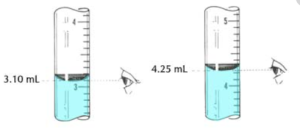9 Procedures for Weight and Volume Measurement
Accurate weight and volume measurement is a foundational skill in pharmacy compounding, directly impacting the safety, efficacy, and consistency of compounded preparations. Even small deviations in measurement can lead to underdosing, overdosing, instability, or treatment failure. For this reason, pharmacy personnel must be proficient in using appropriate tools—such as balances, syringes, and graduated cylinders—and must understand the procedures required to achieve precise results.
This chapter outlines standardized techniques for weighing solids and measuring liquids, identifies common sources of error, and highlights key principles such as equipment calibration, correct positioning, and reading measurements at eye level. Emphasis is placed on best practices that support quality assurance and regulatory compliance in accordance with Canadian standards for pharmacy compounding. Mastery of these skills is essential to ensure patient safety and the delivery of high-quality medications.
Weighing Procedure
-
Use balance on level and stable surface, free from drafts
- Check the balance leveling bubble and calibration before use.
- Tare (zero) the balance before weighing ingredients.
- Place labelled weighing paper or a weigh boat on the balance (middle of the pan).
- tare balance to zero out weight of the weigh paper or weigh boat
- Slowly add the ingredient until the desired weight is reached.
- Remove and transfer the measured ingredient carefully.
- Clean the balance after use to avoid cross-contamination.
- Use a clean weigh paper or boat for each ingredient.
Common Errors in Weighing
- Not taring the balance before weighing
- Failing to zero the scale before adding ingredients leads to inaccurate measurements
- Using a balance that is not level or calibrated
- Adding too much or too little ingredient due to improper handling
- Air currents or vibrations affecting measurement accuracy
-
Transferring incorrectly
-
Not transferring the entire weighed amount (e.g., powder stuck to weigh paper or spatula) causing underdosing
-
- Incorrect container placement
- Placing the weigh paper or boat off-center on the scale pan can affect the reading
- Not knowing the minimum weighable amount based on manufacturer specifications
Liquid Measurement Procedure
- Select the appropriate measuring device (graduated cylinder, pipette, syringe, etc.).
- Pour the liquid slowly into the container.
- When pouring liquids from a stock bottle, pour from the opposite side of the stock bottle label to avoid spillage on the label.
- Read the liquid level at eye level, using the bottom of the meniscus.
- Transfer the measured liquid into the formulation as needed.
-
Clean stock bottle (including threads) after measuring.
How to Measure in a Graduate:
- Graduated cylinder must be on a flat surface.
- Eye position is level to the surface of the liquid.
- Read volume at the bottom of the meniscus.
- Read the numbered line below the meniscus. Add the incremental measurements up to the last mark below the meniscus
- Once you have documented your measurement, use the count-up method. Keep reading past your meniscus up to the next gradation to ensure you are using the correct sub-gradation…your count should match the next gradation!!

Common Errors in Volume Measurement
- Not reading the meniscus at eye level
- Looking from above or below leads to incorrect volume interpretation
- Using an incorrect measuring device
- Using too large of a measuring device for too small of a volume reduces accuracy *Remember the 20% rule
- Pouring too quickly
- Can cause splashing, spills or excess volume
- Using contaminated or wet measuring devices
- Residual moisture or previous compounds can affect the volume and stability of a new preparation
- Failing to account for liquid adhesion to the container walls (especially with viscous liquids)
- Not calculating the correct sub gradations on the device
- **This is a major point of error- this must be done correctly
-
Not allowing time for proper drainage of graduated cylinders to minimize loss
-
May need 1 minute to allow liquid to drain, especially viscous liquids
-
Other Considerations:
- Weights are additive in most mixtures
- Volumes may or may not be additive (may have contraction or expansion)
- Mixing liquids requires appropriate qs procedures
- If qs’ing with blend of vehicles, must blend them first then qs with combined vehicle
- Dilutions, fortifications, and aliquots may be employed to obtain desired amounts or concentrations
Proper use of measuring devices for weight and volume are critical to ensure patients are receiving the correct doses of their medication. Please watch the provided videos to learn more.
Here are links to some helpful videos:
How to use graduate cylinders:
https://www.youtube.com/watch?v=SE-nUsrbELE
How to use an electronic scale:
https://www.youtube.com/watch?v=0UymyTJATLc
How to use syringes:
https://www.youtube.com/watch?v=_TnDr8cKums&t=3s
Measuring ingredients accurately—both by weight and by volume—is essential to successful non-sterile compounding. Pharmacy technicians must consistently apply correct procedures, select the most accurate tools for the job, and remain vigilant against common errors. Ensuring balances are tared and calibrated, reading the meniscus properly, using clean equipment, and transferring ingredients completely are non-negotiable elements of safe and effective practice.
As you progress in your compounding education, these fundamental techniques will support more complex tasks such as preparing aliquots, performing dilutions, or qs’ing to volume. A strong understanding of measurement procedures not only supports regulatory compliance but also reinforces your critical role in promoting patient safety. Continue to practice these techniques with care, attention to detail, and adherence to best practices outlined in this chapter—and consult provided videos and reference tools to deepen your confidence and accuracy.

